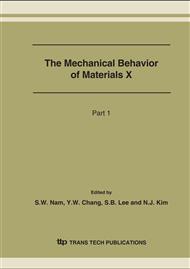p.697
p.701
p.705
p.709
p.713
p.717
p.721
p.725
p.729
Evaluation of Friction Force, Wear Volume and Scuffing Life of Piston Rings and Cylinder Blocks with Different Surface Roughness for Low Friction Diesel Engine
Abstract:
Wear and scuffing tests were conducted using friction and wear measurement of piston rings and cylinder blocks for the low friction diesel engine. Scuffing, described as sudden catastrophic failure of lubricated sliding surfaces, usually characterized by a sudden rapid increase in friction, temperature and noise, is an important failure mode on sliding surfaces. In this study, the frictional forces, wear amounts and cycles to scuffing in boundary lubricated sliding condition were measured using the reciprocating wear tester. The cylinder blocks with several values of surface roughness were used as reciprocating specimens, and a piece of piston ring was used as fixed pin. As increasing load by several steps in lubricated sliding, the friction signals indicated the state of surface interactions, such as friction forces, changes of lubricating films and scuffing. There were some rapid increases in friction forces just before the scuffing would occur. It was found that there was the optimum value of initial surface roughness to prolong the wear life of sliding surfaces. As decreasing the surface roughness of cylinder blocks, the wear amounts were decreased due to increasing the contact area. There was also the optimum surface roughness to reduce the friction and to prolong the scuffing life.
Info:
Periodical:
Pages:
713-716
Citation:
Online since:
August 2007
Authors:
Keywords:
Price:
Сopyright:
© 2007 Trans Tech Publications Ltd. All Rights Reserved
Share:
Citation:


